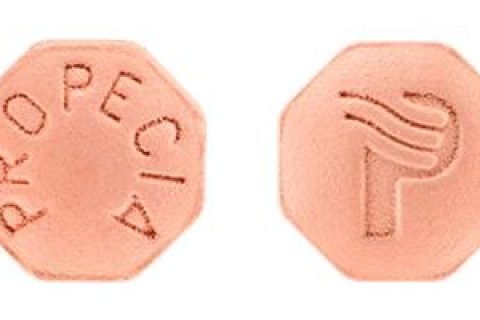
Propecia
Propecia is a prescription drug used for the treatment of male-pattern hair loss (androgenetic alopecia). It is the only oral prescription medication approved by the U.S. Food and Drug Administration for this purpose.
- Medically reviewed by Jessica D. Hess, Ph.D.
- Last update: March 13, 2025
What Is Propecia?
Propecia (finasteride) and its generic versions are the only oral prescription drugs approved for treatment of male-pattern baldness. Propecia is part of a class of drugs known as 5-alpha-reductase inhibitors (5-ARIs). It is approved only for use in men because it can cause ambiguous genitalia in developing male fetuses.
Drugs in the 5-ARI class include finasteride, marketed under the brand names Proscar (5 mg) and Propecia (1 mg); and dutasteride, marketed as Avodart and Jalyn (in combination with tamsulosin).
Proscar, Avodart and Jalyn are approved to treat symptoms of an enlarged prostate gland, or benign prostatic hyperplasia. Proscar and Avodart are also approved to reduce the risk of urinary retention or the need for BPH-related surgery.
Propecia is the only 5-ARI approved to treat male-pattern hair loss. Dutasteride is not formally approved for treating hair loss, but it may be used off-label for this purpose.
In order to be effective, finasteride must be taken indefinitely, as discontinuation results in the return of hair loss. While patients are expected to take finasteride over an extended period, little is known about the long-term effects of drugs in this class.
How Propecia Works
Propecia works by stopping the production of DHT in the body and this helps slow hair loss in about 86% of men who take the drug, according to the American Hair Loss Association. The drug’s label instructs users to take one 1 milligram tablet once daily, with or without meals.
Baldness is caused when an enzyme changes testosterone into something called dihydrotestosterone. The enzyme that transforms testosterone into DHT is known as 5α-reductase (5α-R). DHT, in turn, affects some hair follicles that are sensitive to the enzyme, binding to the follicles and causing them to shrink and produce thinner, shorter hairs. Eventually the follicles will stop hair production entirely.
Within 24 hours of taking a dose of Propecia, the concentration of DHT drops by 65 percent. The full effects of daily Propecia use can take three months or more to appear. Stopping treatment leads to reversal of effect within 12 months, according to the label.
Decreased Sex Drive, Depression & Other Side Effects
According to Merck, the most common side effects of using Propecia include decreased sex drive, trouble getting or keeping an erection and a decrease in the amount of semen.
The manufacturer says the following side effects have also been reported:
- Allergic reactions such as rash, itching, hives, or swollen lips, tongue, throat and face
- Breast tenderness and enlargement
- Decrease in sex drive that continues even after patients stop taking Propecia
- Depression
- Infertility
- Male breast cancer (rare)
- Pain in the testicles
- Problems with ejaculation that continue after stopping Propecia
- Prostate cancer
According to a 2016 research review, several large studies found no increase in prostate cancer and no change in survival rate of patients who took 5-alpha-reductase inhibitors, but identified an increased incidence of aggressive types of prostate cancer associated with their use. It also found no direct link between 5-alpha-reductase inhibitors and depression, although the results of several small studies led to depression being listed on the label as a side effect. Sexual effects – such as erectile dysfunction and decreased libido – were reported in 3.4% to 15.8% of men.
In 2022, the FDA announced a requirement to disclose suicide risk as a potential effect of anti-baldness drugs.
Other Hair Loss Treatments in Development
Medical researchers continue to explore alternative treatments for hair loss. For example, cyclosporine A, originally used for transplant patients and people with autoimmune diseases, has been found to stimulate hair growth.
On a different front, platelet-rich plasma therapy is being investigated to treat baldness. The therapy is used to hasten healing in a variety of medical fields, including dentistry and orthopedics. In PRP therapy, a person’s own blood is placed into a centrifuge to separate the red blood cells from the plasma. The plasma, containing growth factors, is then injected back into the patient. When PRP therapy is used for hair loss treatment, the plasma is injected directly into the patient’s hair follicles.
Another team of researchers is developing a device they are describing as a flexible, wearable photostimulator that has demonstrated the ability to grow hair on mice.
In Texas, researchers are looking at a protein known as KROX20 that purportedly tells skin cells to become hair and then to produce a protein that plays an important role in pigmentation of the hair.
Researchers elsewhere are examining possible genetic treatments, as well as treatments to generate stem cells.
Buyer Beware
Experts advise patients to be wary of treatments that claim to restore hair but have not been properly studied. Among the treatments patients should be wary of are brushes, magnets and massagers that purport to stimulate blood circulation to the hair follicles.
These claims are not supported by any reliable evidence. The same holds for a variety of herbal supplements. Bottom line: Talk to your doctor before trying any medical treatments for hair loss.
Calling this number connects you with a Drugwatch.com representative. We will direct you to one of our trusted legal partners for a free case review.
Drugwatch.com's trusted legal partners support the organization's mission to keep people safe from dangerous drugs and medical devices. For more information, visit our partners page.


